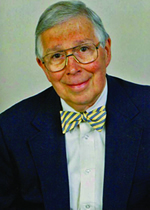Dr. Yazbeck is an Internal Medicine Resident at SUNY Upstate Medical University in Syracuse, NY.
William J. Williams, MD, has left a unique stamp on the field of hematology through his exemplary patient care and research, and he also wrote “the book” on the field, editing what became for most of the 1970s and 80s one of the two most familiar English-language hematology textbooks. The book, originally called Hematology remains in wide use along with an expanding group of other excellent texts. To honor his contributions as founding editor, the name of the book was changed to Williams Hematology beginning with the fifth edition.
Dr. Williams has an established history of leadership, serving as dean of the College of Medicine and vice president for Biomedical Sciences at SUNY Upstate Medical University from 2002 to 2004. He was named a Distinguished Service Professor by the State University of New York in 2002, and he remains an inspiring teacher today, grounding students in both the science and art of medicine.
During teaching rounds, he frequently says, “Just because someone knows how to physically take care of a patient doesn’t mean that person will automatically have a good doctor-patient relationship. Some of this is instinctual, but it also must be taught and explained to students — we can’t just expect they will pick it up by observing.” Through his guidance of the medicine department, Dr. Williams was known as the man with the bow tie and gentle smile who added a humanistic touch to a competitive field. He knew each trainee well and would occasionally surprise them with a T-shirt, a book, or a personal gift.
Drs. David Duggan, Chairman of Internal Medicine at SUNY Upstate Medical Center, and William Williams.
Drs. David Duggan, Chairman of Internal Medicine at SUNY Upstate Medical Center, and William Williams.
Dr. Williams was born in a small town in New Jersey, where he first acquired his desire to go into medicine. His family doctor, whom he described as a “hero,” suggested that he consider a career in medicine. While reading the Sinclair Lewis novel Arrowsmith in college, he acquired an interest in academic research, seeking to emulate the book’s hero, Martin Arrowsmith, who chose a research career. Arrowsmith was all the things Williams wanted to be, and he vowed to follow this new role model. While an apprentice seaman in the Navy in 1945, he was assigned to the hematology laboratory at the U.S. Naval Hospital in Philadelphia, even though he had originally asked to go into the chemistry lab. While he was working daily in the hematology lab, he was able to see the close association between the laboratory and clinical problems. With this, a career was born.
From left to right: Drs. Maxwell Wintrobe, William Dameshek, Thomas Hale Ham, William Williams and Fraser Mustard (in the back) at the American Society of Hematology annual meeting in 1965.
From left to right: Drs. Maxwell Wintrobe, William Dameshek, Thomas Hale Ham, William Williams and Fraser Mustard (in the back) at the American Society of Hematology annual meeting in 1965.
He was soon transferred to the medical school at the University of Pennsylvania, from which he graduated in 1949. In fact, he remained there until 1969, serving as chief of the Hematology Section and professor of medicine, except for the 18 months he spent at Washington University of Saint Louis, working with Carl Moore and William Harrington. He also spent a year at Oxford University with R. G. Macfarlane and M. Peter Esnouf. He did research on the biochemical mechanisms of blood coagulation, specifically the initiation of blood clotting by Russell’s viper venom and tissue factor. He also participated in projects on methylmalonic acid excretion in vitamin B12 deficiency, carbon monoxide production as a measure of hemolysis, and phospholipid metabolism in platelets and leukocytes. Later he studied peripheral blood stem cells and spent a sabbatical working with Donald Metcalf at the Walter and Eliza Hall Institute of Medical Research.
When he joined the faculty of the State University of New York Upstate Medical Center in 1969, he became the Edward C. Reifenstein Professor of Medicine and Chairman of the Department of Medicine, where he served for 22 years. In his early years, he attracted excellent faculty members including Arlan Gottlieb, Robert Comis, and Kenneth Zamkoff, who were the leaders of hematology-oncology at that time, and their legacy continues to this day.
He began working on Hematology in the mid-1960s, in collaboration with Ernest Beutler, Allen Erslev, and Wayne Rundles, who was replaced by Marshall Lichtman after the second edition. Dr. Williams continued as editor-in-chief through the fourth edition, when the name was changed to Williams Hematology. The book is currently in its seventh edition.
Many residents were attracted to Syracuse because of his textbook, and they remained on the faculty because of his outstanding leadership, vision, and support of research and academic growth. But, most of all, those who know him remember best his big heart and his penchant for looking after them.



